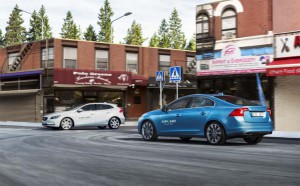With a record 54 million vehicles facing recall — and nearly another month to go before the books are closed on 2014 — it’s no surprise American automakers and auto buyers alike have been focused on safety this year.
But despite all the lapses that have seen dozens of deaths from faulty airbags and flawed ignition switches, there’s another side to the story: cars are safer than ever. U.S. highway fatalities are now about 40 percent down from their 1970s peak, even though there are more cars on the road logging more mileage.
“I don’t think we’ve ever seen vehicle safety reach this level before,” contends Raj Nair, global product development director for Ford Motor Co.
The latest vehicles are not only better-equipped to survive crashes but also to avoid them altogether. That’s led several automakers, including both Nissan and Volvo, to declare that they hope to see no deaths occur in the new vehicles they bring to market by the beginning of the next decade.
That’s not as tall an order as it might seem. The Insurance Institute of Highway Safety is preparing a new study that will show a number of vehicles already on U.S. roads experienced no fatal crashes during a three-year period. The key, according to the group’s executive vice president Russ Rader, is “new safety technologies like electronic stability control.”
Designed to prevent skids while driving on slick roads, ESP was a breakthrough system little more than a decade ago. Today, it is mandated for all vehicles sold in the U.S. market. The National Highway Traffic Safety Administration will soon make backup cameras standard gear, as well. And the agency is looking at even more advanced “active” safety systems to come.
(NHTSA debates how far to expand Takata airbag recall. Click Here for the latest.)
What’s exciting many safety advocates is that the auto industry is often taking the lead, bringing new features to market faster than required. Honda, for example, is now making backup cameras standard in all its new models, including the entry-level HR-V crossover-utility vehicle it is showing off at the Los Angeles Auto Show.
The L.A. extravaganza put a premium on top-line models, such as the new Mercedes-Maybach S600 limousine, which is expected to start at somewhere around $250,000 when it comes to market next year.
The German maker has traditionally used the high end of its line-up to introduce new safety technologies. The latest-generation S-Class, introduced for the 2014 model-year, added such advancements as a “Magic” vision system to automatically adjust its suspension to road conditions, Infrared Night Vision that can spot and identify pedestrians and animals on a pitch-black road, and a collision avoidance system that can automatically brake if it senses a potential crash.
(Inside story: How GM botched its ignition switch recall. Click Here for more.)
These safety systems are migrating down-market on Mercedes’ new 2015 C-Class model. And a significant number of these technologies are, or soon will be, available in mainstream brands.
Automakers are focusing on two distinct areas: active safety systems such as collision warning with auto-braking; and passive safety technologies that increase the odds of survival in even the worst crashes. The number of vehicles surviving the toughest new crash tests run by the Insurance Institute has rapidly risen – in part due to the use of high-tech computer-animated design and engineering tools, as well as the introduction of advanced new materials, such as ultra-high-strength steel.
Expect to see a significant number of new technologies debut over the next few years as automakers race to see who will be first to market with a fully autonomous vehicle. Nissan has said it wants to have a self-driving car on the road by 2020. But Cadillac is looking to introduce its SuperDrive, which will allow hands-off motoring on limited-access highways, in 2016. The various technologies that will allow autonomous driving will likely be introduced as individual features, industry analysts forecast.
(OPEC assuring fuel prices will stay low for some time. Click Here for the latest.)
With the exception of blips in 2011 and 2012, highway fatalities have been steadily falling, and are expected to be down by almost 20 percent for 2014 compared to the 39,252 Americans who died on the road in 2005.
That’s still a long way from zero, and there are plenty of skeptics who question if – or when – it would be possible to reach that level. But, if anything, this year’s crackdown on safety defects – especially those automakers might have knowingly ignored – may help make the roads safer going forward.
A version of this story first appeared on NBCNews.com.

